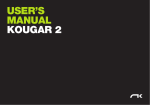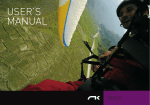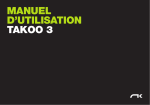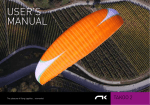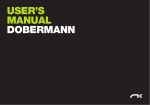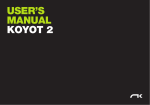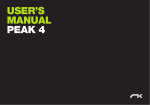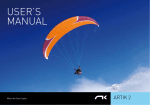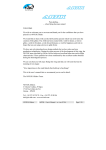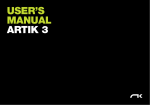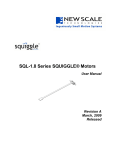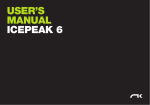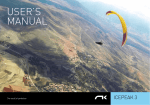Download USER`S MANUAL TAKOO 3
Transcript
USER’S MANUAL TAKOO 3 WELCOME Freedom & Serenity NIVIUK Gliders TAKOO 3 WELCOME This manual offers all the necessary information that will familiarize you with the main characteristics of your new paraglider. Although this manual informs you about your glider, it does not offer the instruction requirements necessary for you to be able to pilot this type of wing. Flying instruction can only be set by the competent organism in your country of flying zone. We wish to welcome you to our team and thank you for the confidence that you have placed in a NIVIUK Glider. We would like to share with you the commitment, the passion and emotions of the Niviuk design team, which have resulted in the creation of the new TAKOO 3. Niviuk are very proud of this new glider, a glider carefully designed to share, to allow you and your passenger to discover the passion of flying together in tandem. It keeps the best bits of the TAKOO 2, but improving them to turn into an easy glider but with enough strength to be the main feature of new neverending dual adventures. It provides easier take off, better inflation, more progressive turning, easier landing and better control than the TAKOO 2. The more the pilot enjoys flying the glider the more the passenger does. We are confident that you will enjoy flying this wing and that you will soon understand the meaning of our slogan:“The importance of small details” This is the user’s manual that we recommend you to read in detail. The NIVIUK Gliders Team. NIVIUK GLIDERS & AIR GAMES SL C/ DEL TER 6, NAVE D 17165 LA CELLERA DE TER - GIRONA - SPAIN TEL. +34 972 42 28 78 FAX +34 972 42 00 86 [email protected] www.niviuk.com 2 USER’S MANUAL Nevertheless we remind you that it is important that you carefully read all the contents of the manual for your new TAKOO 3. Severe injuries to the pilot and passenger, including death, can be the consequence of the misuse of this equipment. Neither the manufacturer nor the dealers or sellers of this product are responsible of the damage derived from using this glider inappropriate way. Only the pilot is entirely accountable for any damage derived there from. SUMMARY WELCOME2 5. LOSING HEIGHT 10 USER’S MANUAL 2 5.1 EARS “EARS LOCK SYSTEM” 11 1. CHARACTERISTICS 4 5.2 B-LINE STALL 12 1.1 WHO IS IT DESIGNED FOR? 4 5.3 SLOW DESCENT TECHNIQUE12 1.2 CERTIFICATION 4 6. SPECIAL METHODS 12 1.3 IN-FLIGHT BEHAVIOUR 4 6.1 TOWING 12 1.4 ASSEMBLY, MATERIALS 4 6.2 ACROBATIC FLIGHT 12 1.5 ELEMENTS, COMPONENTS 5 7. FOLDING INSTRUCTIONS 12 2. UNPACKING AND ASSEMBLY 5 8. CARE AND MAINTENANCE 13 2.1 CHOOSE THE RIGHT PLACE 5 8.1 MAINTENANCE 13 2.2 PROCEDURE 5 8.2 STORAGE 13 2.3 ASSEMBLY OF THE HARNESS 6 8.3 CHECKS AND CONTROLS 13 2.4 TYPE OF HARNESS 6 8.4 REPAIRS 13 2.5 TRIM DISPLAY 6 9. SAFETY AND RESPONSIBILITY 13 10. GUARANTEE 14 2.6 INSPECTION AND WING INFLATION ON THE GROUND 6 11. TECHNICAL DATA 15 2.7 ADJUSTING THE BRAKES 7 11.1 TECHNICAL DATA 15 3. THE FIRST FLIGHT 7 11.2 MATERIALS DESCRIPTION 15 3.1 CHOOSE THE RIGHT PLACE 7 11.3 RISERS ARRANGEMENT 16 3.2 PREPARATION 7 11.4 LINE PLAN 17 3.3 FLIGHT PLAN 7 11.5 LENGHTS TAKOO 3 42 18 3.4 PRE-FLIGHT CHECK LIST 7 11.6 CERTIFICATION SPECIMEN TEST 19 3.5 WING INFLATION, CONTROL, AND TAKE-OFF7 3.6 LANDING 8 4. IN FLIGHT 8 4.1 FLYING IN TURBULENCE 8 4.2 POSSIBLE CONFIGURATIONS 8 4.3 USING THE TRIM DISPLAY 10 4.4 FLYING WITHOUT BRAKE LINES 10 4.5 KNOTS IN FLIGHT 10 3 1. CHARACTERISTICS 1.1 WHO IS IT DESIGNED FOR? The TAKOO 3 has been designed to satisfy all the tandem pilot’s demands. If the pilot does not have pleasure flying, the passenger will not enjoy all the aspects of flying. This is one of the main arguments that the NIVIUK team has defended during the development and the finalization of the TAKOO 3. 1.2 CERTIFICATION The TAKOO 3 passed the certification according to European EN / LTF rules. This test was carried out in the Swiss Air-Turquoise laboratories in Switzerland. The Takoo 3 in size 42 passed the required test with excellent results. The certification result achieved on the TAKOO 3 for size 42 is: EN/LTF B We recommend paying special attention to the flight test report made by the certification laboratory especially the test pilot comments (Point 25 on the flight test report). On the flight test report there is all necessary information to know how the new paraglider will react on each manoeuvre tested. It is important to take into account that each size can have a different reaction to the same manoeuvre. Furthermore, the same size at maximum load can result in a different behaviour at minimum load. Check the certification results and figures on the last pages of this manual or at www.niviuk.com high performance whilst achieving a high level of safety, numerous adjustments have been made over many hours of test flights and by using several prototypes. Different prototypes were then tested in all types of flight conditions. This intense development work supported by the combined experience of the whole team has achieved a wing with unbeatable behaviour. The wing’s behaviour on the ground is the first quality of its obedient temperament. Its lightness and the ability for the pilot to be in command of the glider are so decisive that all actions that are taken during the flight result in total freedom. This wing’s performance will make quite clear that lightness and efficiency are complementary concepts. Even in the most turbulent conditions all instructions are diligently transmitted and the response given by the TAKOO 3 is the expected response. The pilot will discover the manoeuvrability of this wing in all the aspects of piloting allowing the pilot to explore beyond their present knowledge without running the risk of an incorrect response of the TAKOO 3. Landing is clean, easy, precise, without imperfections, the pilot can adapt his final to every situation. The wing’s safety is guaranteed by its excellent homologation certifications. It is worthwhile remembering that the best tandem in the hands of a bad pilot does not guarantee a happy ending. The TAKOO 3 passive safety measures should also be accompanied by the passive safety offered by the rest of the flying equipment: the harness, helmet, emergency parachute etc. The extraordinary behaviour of the TAKOO 3 and common-sense piloting will give you many hours of peaceful flying. 1.4 ASSEMBLY, MATERIALS 1.3 IN-FLIGHT BEHAVIOUR It has taken years of dedicated work to create a glider of such 4 The TAKOO 3 does not only introduce new design methods but also new manufacture technologies. The fabrics used in the construction of the TAKOO 3 have been carefully selected for their lightweight, UV standards and resilient properties when used during normal conditions. Not a single millimetre of error is possible in the manufacturing process from Olivier’s computer to the cutting of the fabric. An automatic process controlled by a laser-cutting program cuts each of the sections that compose the different parts of the wing. This program not only cuts the pieces of fabric but it also paints the guideline marks that will aid the assembly; it also numbers the separate pieces of material. All this is carried out before human handling of the pieces begins. So we eliminate possible and understandable errors that may occur during this delicate procedure. The lines are semi-automatically manufactured and all the sewing is finished under the supervision of our specialists. The jigsaw puzzle of the assembly process is made easier using this method. We minimize the processes while making the quality control more efficient. All the different parts of the canopy are cut and assembled under the strict conditions induced by the automation of the whole process. All NIVIUK Gliders go through an extremely thorough and efficient final inspection. Every single line of each glider is measured individually once the final assembly has concluded. Each wing is then individually inflated for the last visual revision. Each glider is packaged following the maintenance and conservation instructions recommended for the advanced materials. NIVIUK Gliders are made of first class materials as demanded by the performance, durability, and homologation requirements of the present-day market. Information about construction materials is given on the last pages of this manual. 1.5 ELEMENTS, COMPONENTS The TAKOO 3 is delivered to its owner together with a series of components that, although not fundamental, do take an important part in the use, transport and storage of the paraglider: - The new large capacity KARGO rucksack 220L. - A small fabric repair including auto adhesive rips top (same colours of the wing) and replacement maillon blockers. - Spreader bar (rigid or soft) The user’s manual with the answers all our questions about our new TAKOO 3 is available at www.niviuk.com 2. UNPACKING AND ASSEMBLY 2.1 CHOOSE THE RIGHT PLACE We recommend that you unpack and assemble your wing on a schooling slope or a flat clear area without too much wind and free of obstacles. These conditions will allow you to carry out all the steps required for you to check and inflate the TAKOO 3. We recommend that an instructor or a retailer supervises the entire procedure as only they are competent to resolve any doubt in a safe and professional way. 2.2 PROCEDURE Take the paraglider out of the rucksack, open it and spread it open, with the lines on top of the underside, position the wing as if you were to inflate it. Check the condition of the fabric and the lines; make sure there are no abnormalities. Check the maillons that attach the lines to the risers are properly closed. Identify and order the A, B, C lines, the brake lines 5 and the corresponding risers. Make sure that there are no ties or knots. 2.3 ASSEMBLY OF THE HARNES Correctly place the risers on the superior loop of the triangle of the spread system. The risers and lines should not have any twists and they should be in the right order. Check if the harness carabineers are correctly locked. Secondly, you should connect the spreader bar system to the pilot’s harness and, at last, connect the passenger’s harness. 2.4 TYPE OF HARNES The PEAK 3 has been certified on EN D with a harness according to the following rules: • 2. DV LuftGerPV §1, Nr. 7 c (LTF) • European Standard EN 926-2 • European Standard EN 926-1 This certification allows it to be flown with most of the harnesses on the market. We recommend you only to use, as well for the pilot as for the passenger, special designed harnesses for tandem flights. speed of the trims to the landing circumstances. The TAKOO 3 offers to the pilot excellent control when landing either with neutral or opened trims. Use of the trims: The trim buckle is covered with a neoprene shell protection in order to avoid any tangle between lines and risers. The trims have to be manually activated by the pilot. They are placed on the D-riser, one in each side. To open the trims push the buckle of the trim to the inside and release it once in the right position. To close them pull the trim straps down and release it once in the right position. Once the trims have been set they have to be kept symmetrically. Four marks at the length of the trim tape assist us to find that symmetry and check the acceleration position. A locking system is located at the end of the trim tape. Thanks to it the surpluses of the trim tape don’t bother you during the flight. The trims mustn’t be used to pilot the glider. The pilot should be aware that opening the trims elevates the break handle to the same distance of the trims displacement. 2.5 TRIM DISPLAY The acceleration mechanism of the TAKOO 3 works when you release the “Trims” on the D-riser. The efficiency of this system provides a wide range of speeds. To reduce the speed, pull the strap to obtain the desired speed. The range of the acceleration system starts at the neutral position up to the maximum speed when it is completely released and vice versa up to the neutral position. The trims can be set in flight: slow speed (neutral trims) – fast speed (opened trims). For landing we recommend to set the trims in the first position of the acceleration range. However, the pilot should change the 6 We recommend adapting the piloting of the wing depending on the load and the displacement of the trims. Look also at the graphics at the end of this manual. 2.6 INSPECTION AND WING INFLATION ON THE GROUND Once you have checked all the equipment and made sure that the wind conditions are favourable, inflate your TAKOO 3 as many times as necessary in order to become acquainted with the wing’s behaviour. The TAKOO 3 inflates easily and smoothly. An excess of energy is not necessary and the wing will inflate with minimum pressure on the harness when you move forward. This may be assisted by using the A lines. Do not pull on them, just lift to accompany the natural rising movement of the wing, once the wing is in the 12 o’clock position, simply apply correct pressure on the brake lines and the TAKOO 3 will sit over your head. 3.3 FLIGHT PLAN Draw out a flight plan before take-off in order to avoid possible flight errors. 3.4 PRE-FLIGHT CHECK LIST 2.7 ADJUSTING THE BRAKES The length of the main brake lines is adjusted at the factory to the length established during homologation. However, the length can be changed to adapt to the pilot’s flying style. Nevertheless, we recommend that you fly for a while with these, set at the original length. This will allow you to become accustomed to the TAKOO 3’s original flying behaviour. If you then decide to change the length of the brake lines, untie the knot, slide the line through the brake link to the desired length, and strongly re-tie the knot. Qualified personnel should carry out this adjustment. You must ensure that this adjustment does not slow down the glider without any pilot input. Both brake lines should be symmetrical and measure the same length. The most recommended knots are the clove hitch knot or bowline knot. 3. THE FIRST FLIGHT 3.1 CHOOSE THE RIGHT PLACE We recommend that the first flight with your TAKOO 3 is made on a smooth slope (a school slope) or in your usual flying area accompanied by a qualified instructor. 3.2 PREPARATION Repeat the procedures detailed in chapter 2 UNPACKING AND ASSEMBLY in order to prepare your equipment. Once you are ready, but before you take-off, carry out another equipment inspection. Ensure correct installation of all equipment and that all lines are free of hindrances or knots. Check that the weather conditions are suited for your flying skills. 3.5 WING INFLATION, CONTROL, AND TAKE-OFF Smoothly and progressively inflate the wing (chapter 2.6 INSPECTION AND WING INFLATION ON THE GROUND). The TAKOO 3 inflates easily and does not require excessive energy. It does not tend to over-take you, so the wing inflation phase is carried out without anguish. These take off characteristics provide a perfect control phase and enough time for the pilot to decide whether to accelerate and take off. Whenever the wind speed allows it, we recommend a reverse launch technique; this type of launch allows you to carry out a better visual check of the wing. The TAKOO 3 is especially easy to control in this position in strong winds. However, wind speeds up to 25 to 30 km/h are considered strong and extra consideration should be given to any thought of flight. Preparation and positioning of the wing on the takeoff is especially important. Choose a location which is appropriate for the direction of the wind. Position the paraglider as if it were part of a large circle, taking into account the shape of the canopy in flight. All this will assist in a trouble free take-off. 7 3.6 LANDING 4.2 POSSIBLE CONFIGURATIONS The TAKOO 3 lands excellently, it transforms the wing speed into lift on the pilot’s demand, allowing an enormous margin of error. You will not have to wrap the brake lines around your hand to get greater braking efficiency. We recommend that training to master these manoeuvres be carried out under the supervision of a competent school. The pilot should always act on the brakes depending on the load/m² of the moment, avoiding overhandling with a small load or a lack of energy with a high load. The TAKOO 3 absorbs the speed in order to allow you a perfect landing, even on days with nil wind. On the flight test report there is all necessary information to know how the new glider will react on each manoeuvres tested. It is important to take into account that each size can have a different reaction on the same manoeuvres. Furthermore, the same size on maximum load o minimum load can experiment a different behaviour. 4. IN FLIGHT 4.1 FLYING IN TURBULENCE The TAKOO 3 complies with an excellent certification to face this type of situation with the best safety guarantee. This wing is stable in all types of weather conditions. It reacts admirably in passive flight, thus offering a high level of safety in turbulent conditions. Nonetheless, all gliders always have to be piloted according to the prevailing weather conditions; the pilot is the ultimate safety factor. We recommend that the pilot adopts a proactive attitude when flying, making the necessary fine adjustments to keep the wing in control. He should avoid the glider to collapse, by acting correctly to increase the speed of his glider. He/she should stop braking to allow it to fly at the required wing speed after a correction is made. Do not maintain any correction for longer than necessary (braked) this would cause the wing to enter into critical flying situation. Whenever necessary, control a situation, react to it and then re-establish the required speed. 8 Only knowing that we will be able to forecast how our glider will react during these manoeuvres when flying and how we have to act to in each situation. Our recommendation is these manoeuvres are to be taught under the control of a flight school within a S.I.V course. Asymmetric collapse In spite of the great stability of the profile of the TAKOO 3, heavy turbulent conditions may cause part of the wing to collapse asymmetrically. This usually happens when the pilot has not foreseen this possible reaction of the wing. When the wing is about to experience an asymmetric collapse the brake lines and the harness will transmit a loss of pressure to the pilot. To prevent the collapse from happening, pull the brake line corresponding to the compromised side of the wing, this will increase the angle of incidence. If the collapse does happen the TAKOO 3 will not react violently, the turn tendency is very gradual and it is easily controlled. Lean your body towards the side that is still flying in order to counteract the turn and to maintain a straight course, if necessary slightly slow down the same side. The collapse will normally open by itself but if that does not happen, pull completely on the brake line on the side, which has collapsed (100%). Do this with a firm movement. You may have to repeat this operation to provoke the re-opening. Take care not to over-brake on the side that is still flying (turn control) and when the collapse has been solved; remember to let the wing recover its flying speed. Symmetric collapse In normal flying conditions the design of the TAKOO 3 ensures that a symmetric collapse is quite improbable. The profile of the wing has been designed to widely tolerate extreme changes in the angle of incidence. A symmetric collapse may occur in heavy turbulent conditions, on entry or exit of strong thermals or lack of adapting the use of the accelerator to the prevailing air conditions. Symmetrical collapses usually re-inflate without the glider turning but you can symmetrically apply the brake lines with a quick deep pump to quicken the re-inflation. Release the brake lines immediately to recover optimum flight speed. Negative spin This configuration is out of the normal flight behaviour of the TAKOO 3. Certain circumstances however, may provoke this configuration such as trying to turn when the wing is flying at very low speed (while heavily braking). It is not easy to give any recommendations about this situation since it varies depending on the circumstances. Remember that you should restore the relative air speed over the wing. To achieve this, progressively reduce the pressure on the brake lines and let the wing gain speed. The normal reaction would be a lateral surge with a turn tendency no greater than 360º before restoring to normal flight conditions. Parachutal stall The possibility of this happening has been eliminated by the design of the TAKOO 3 and it is highly unlikely to happen on this paraglider. If it does happen, the feeling would be that the wing would not be advancing; you would feel a kind of instability and a lack of pressure on the brake lines, although the canopy would appear to be correctly inflated. The correct reaction would be to release the pressure on the brake lines and push the A lines forward or rather lean your body to any side WITHOUT PULLING ON THE BRAKE LINES. Deep Stall The possibility of the TAKOO 3 falling into this configuration during normal flight is very unlikely. This could happen if you are flying at a very low speed, whilst over steering in a number of manoeuvres and in turbulent conditions. To provoke a deep stall you have to take the wing to minimum flight speed by symmetrically pulling the brake lines, when you reach this point, continue pulling until you reach 100% and then hold. The glider will first fall behind you and then situate itself above you, rocking slightly, depending on how the manoeuvre was carried out. When you start to provoke a stall, be positive and do not doubt an instant. Do not release the brake lines when half way through the manoeuvre. This would cause the glider to surge violently forward with great energy and may result in the wing below the pilot. It is very important that the pressure on the brake lines is maintained until the wing is well established vertical above. Wing tangle A wing tangle may happen after an asymmetric collapse, the end of the wing is trapped between the lines (Cravat). This situation could rapidly cause the wing to turn, although it depends on the nature of the tangle. The correction manoeuvres are the same as those applied in the case of an asymmetrical collapse, control the turn tendency by applying the opposite brake and lean your body against the turn. Then locate the line that reaches the stabilizer that is trapped between the other lines. This line has a different colour and belongs to the external lines of the C riser. Pull on this line until it is tense, this should help to undo the wing tangle. If you cannot undo the tangle, fly to the nearest possible landing spot, control the flying course with your body movements and a little pressure on the opposite brake. Be careful when attempting to undo a tangle if you are flying near a mountainside or near to other paragliders, you may lose control of the flying course and a collision may occur. 9 Over handling Most flying incidents are caused by wrong actions of the pilot, which chained one after another create abnormal flying configurations (a cascade of incidents). You must to remember that over handling the wing will lead to critical levels of functioning. The TAKOO 3 is designed always to try to recover normal flight by itself, do not try to over handle it. handle them causing a stall or negative turn. To land you have to let the wing fly at full speed and before reaching the ground you will have to pull symmetrically on both the C-risers. This braking method is not as effective as using the brake lines so you will land at a higher speed. Generally speaking, the reactions of the wing, that follow over handling, are neither due to the input made or the intensity, but the length of time the pilot continues to over handle. You have to allow the profile to reestablish normal flight speed after any type of handling. The best way to avoid these knots and tangles is to inspect the lines before you inflate the wing for take-off. If you notice a knot before takeoff, immediately stop running and do not take off. 4.3 USING THE TRIM DISPLAY The profile of the TAKOO 3 has been designed to fly stable through its entire speed range. It is useful to accelerate “trimmers released” when flying in strong winds or in extreme descending air. When you accelerate the wing, the profile becomes more sensitive to possible turbulence and closer to a possible frontal collapse. If you feel a pressure loss, you should position the “trimmers” in neutral and pull slightly on the brake lines to increase the angle of incidence. Remember that you have to reestablish the flight speed after correcting the incidence. It is NOT recommended to release the “trimmers” near to the mountainside or in very turbulent conditions. If necessary you will have to constantly adjust the use of the trim whilst constantly adjusting the pressure applied to the brake lines. This balance is considered to be “active piloting.” 10 4.5 KNOTS IN FLIGHT If you have taken off with a knot you will have to correct the drift by leaning on the opposite side of the knot and apply the brake line on that side too. You can gently pull on the brake line to see if the knot becomes unfastened or try to identify the line with the knot in it. The identified line can then be pulled to see if the knot undoes. Be very careful when trying to remove a knot. When there are knots in the lines or when they are tangled, do not pull too hard on the brake lines because there is a greater risk of the wing to stalling or negative turn being initiated. Before trying to remove a knot, make sure there are no pilots flying nearby and never try these manoeuvres near the mountainside. If the knot is too tight and you cannot remove it, carefully and safely fly to the nearest landing place. 5. LOSING HEIGHT 4.4 FLYING WITHOUT BRAKE LINES The knowledge of the different descent techniques is an important resource to use in certain situations. The most adequate descent method will depend on the particular situation. If, for any reason at all, you cannot use the brake lines of your TAKOO 3 you will have to pilot the wing using the C-risers and your body weight to fly towards the nearest landing. The C-lines steer easily because they are not under pressure, however you have to be careful not to over We recommend that you learn to use these manoeuvres under the tuition of a competent school. 5.1 EARS “EARS LOCK SYSTEM” The application of “Ears” provides a method of descending moderately at around -3 to -4 m/s. Applying ears increases the angle of attack of the wing and also the loading of the remaining open surface. When the ears are applied it must be appreciated that the ground speed will reduce by 3 to 5 km/h and in order to maintain this descent technique, the pilot must continue to physically hold in the ears. Whilst a solo pilot is applying ears, the angle of attack can be reduced and horizontal/forward speed easily increased by use of the speed (bar) system. This is not an option for a tandem/dual pilot and if holding in the ears by conventional methods, access to the trimmers is also obviously restricted. knot from the V groove. Then guide it vertically as it goes upward and back through the ELS (Lock System) It is better to release the two ears separately. To perform the ears as a descent manoeuvres in the classic way, take the external A line on both sides, as high as possible and pull them downward and outward. You will see the wingtips fold down. To reopen them, release the lines and they will reopen by without assistance. If this does not happen, brake progressively on one side and then the other. Asymmetric reopening is recommended in order to avoid compromising the angle of attack, particularly flying near the ground or in turbulent conditions. Having been recognised these problems; NIVIUK Gliders has improved the EAR LOCK SYSTEM (ELS) applied in the first TAKOO glider. The TAKOO 3 is fitted with big ear pulleys with an ear lock-on system. The improved EAR LOCK SYSTEM (ELS) allows locking and unlocking the ears with no effort of the pilot. The wing can be piloted with the ears on. The ELS allows the pilot to have the ears on all the time with no effort. The ELS allows the pilot to use the trimmers at the same time. The ELS can be regulated to do big ears or small ears. Ears (ELS) ON - Simply take the ear line and pull it downward until the knot passes through the ELS (lock system); then move it slightly horizontally forward, locking the knot in the V groove. Ears (ELS) OFF – To Release, pull the ear line down and release the 11 5.2 B-LINE STALL When you carry out this manoeuvre, the wing stops flying, it loses all horizontal speed and you are not in control of the paraglider. The air circulation over the profile is interrupted and the wing enters into a situation similar to parachuting. To carry out this manoeuvre you have to take the B-lines at the maillons height leaving them as base in the hand palm avoiding taking the A&B together. Pull symmetrically down (approx. 20-30cms) and then hold this position. The initial phase is quite physical (hard resistance) which means that you will have to pull strongly until the profile of the wing is deformed, when this happens the required force will then significantly reduce. To maintain this manoeuvre you must continue to hold the B Lines in the pulled down position. The wing will then become deformed, horizontal speed drops to 0 km/h and vertical speed increases to –6 to –8 m/s depending on the conditions and how the manoeuvre has been carried out. To exit the manoeuvre, simultaneously release both risers, the wing will then slightly surge forward and then automatically return to normal flight. It is better to let go of the lines quickly rather than slowly. This is an easy manoeuvre but you must remember that the wing stops flying, it loses all horizontal movement and its reactions are very different compared to normal flight. This manoeuvre is difficult without the help of the passenger. 5.3 SLOW DESCENT TECHNIQUE Using this technique (do not hurry to descend) we will fly normally, without forcing neither the material nor the passenger. It means looking for descending air areas and turn as it was a thermal – in order to descend. We have to avoid danger areas when looking for descent zones. Safety is the most important thing. 12 6. SPECIAL METHODS 6.1 TOWING The TAKOO 3 does not experience any problem when being towed. Only qualified personnel should handle the qualified equipment to carry out this operation. The wing has to be inflated in the same way as in normal flight. 6.2 ACROBATIC FLIGHT Although the TAKOO 3 has been tested by expert acrobatic pilots in extreme situations, it HAS NOT been designed for acrobatic flight and we DO NOT recommend continued use in this type of flight. Acrobatic flight is the youngest discipline in free flight. We consider acrobatic flight to be any form of piloting that is different to normal flight. To learn safely how to master acrobatic manoeuvres you should attend lessons which are carried out by a qualified instructor and over water. Extreme manoeuvres take you and your wing to centrifugal forces that can reach 4 to 5g. Materials will wear more quickly than in normal flight. If you do practice extreme manoeuvres we recommend that you submit your wing to a line revision every six months. 7. FOLDING INSTRUCTIONS Historically packing a paraglider used to be a case of simply folding the wing in the easiest and most convenient way possible and then placing it into the backpack. However modern design and the introduction of technically advanced materials dictate that the folding of wings now requires more care and attention. Folding should be carried out cell to cell (accordion style) with the sle ribs remaining parallel to the leading edge at all times. The same technique should then be applied to sTe ribs on the trailing edge and when complete the cell structures along the entire chord of the wing should lay parallel and neatly alongside each other. The wing should then be folded into three sections of equal width with each section stacked upon the other. in order to avoid placing undue stress on the internal structures when packed, it is important that each section is folded to the same length as the internal structure of the sle, several smaller folds should be avoided. 8. CARE AND MAINTENANCE Folding should be carried out cell to cell (accordion style) with the ribs remaining parallel to the leading edge at all times. The wing does not have to be tightly folded, if you do so it may damage the material and or the lines. The TAKOO 3 can be optionally delivered with the N-Kare bag. This is an easy folding bag that assists you during the folding process and also can be used as a base surface which protects the glider against damage. More info at http://www.niviuk.com/accessories.asp?id=JNKQKNP4 When the TAKOO 3 is folded, the Kargo rucksack is ready to transport it. 8.1 MAINTENANCE 8.3 CHECKS AND CONTROLS Careful maintenance of your equipment will ensure continued performance. You should ensure your TAKOO 3 is periodically serviced and checked at your local repair shop every 100 hours of use or every year (whichever happens first). This is the only way to guarantee that your TAKOO 3 will continue to function properly and therefore continue fulfilling the homologation certificate results. The fabric and the lines do not need to be washed, if they become dirty, clean them with a soft damp cloth. If your wing gets wet with salty water, immerse it in fresh water and dry it away from direct sunlight. The sunlight may damage the materials of your wing and cause premature aging. Once you have landed, do not leave the wing in the sun, store it properly. If you use your wing in a sandy area, try to avoid the sand from entering through the cell openings of the leading edge. If sand is inside the wing, remove it before folding. 8.4 REPAIRS If the wing is damaged, you can temporarily repair it by using the rip stop that you’ll find in the repair kit, so long as no stitches are involved in the tear. Any other type of tear must be repaired in a specialized repair shop or by qualified personnel. Do not accept a home repair. 8.2 STORAGE It is important that the wing is correctly folded when stored. Store your flying equipment in a cool, dry place away from solvents, fuels or oils. It is not advisable to store your flying equipment in the trunk of your car. Temperatures inside a car parked in the sunlight, can be very high. Inside a rucksack and in the sunlight temperatures can reach 60ºC. Weight should not be laid on top of the equipment. 9. SAFETY AND RESPONSIBILITY It is well known that paragliding is considered a high-risk sport, where safety depends on the person who is practicing it. Wrong use of this equipment can cause severe injuries to the pilot, even death. Manufacturers and dealers are not responsible for any act or 13 accident that may be the result of practicing this sport. You must not use this equipment if you are not trained. Do not take advice or accept any informal training from anyone who is not properly qualified as a flight instructor. 10. GUARANTEE The entire equipment and components are covered by a 2 year guarantee for any manufacture fault. The guarantee does not cover misuse or abnormal use of the materials. 14 11. TECHNICAL DATA 11.1 TECHNICAL DATA 11.2 MATERIALS DESCRIPTION 39 42 NUMBER 54 54 CLOSED 6 6 BOX 29 29 TAKOO 3 CELLS FLAT AREA M2 39 41,5 SPAM M 14,51 14,97 5,4 5,4 33,03 35,15 SPAM 11,5 11,86 ASPECT RATIO 4 4 ASPECT RATIO PROJECTED AREA % LINES RISERS SUPPLIER PORCHER IND (FRANCE) BOTTOM SURFACE SKYTEX 32 70032 E17+ PORCHER IND (FRANCE) PROFILES SKYTEX 40 9017 E29 PORCHER IND (FRANCE) PORCHER IND (FRANCE) DIAGONALS SKYTEX 40 9017 E30 LOOPS LKI - 10 KOLON IND. (KOREA) REIFORCEMENT LOOPS W-420 D-P (GERMANY) TRAILING EDGE REIFORCEMENT MYLAR D-P (GERMANY) RIBS REIFORCEMNET W-420 D-P (GERMANY) THREAD SERAFIL 60 AMAN (GERMANY) 15 15 SUSPENSION LINES FABRIC CODE SUPPLIER 3,33 3,44 UPPER CASCADES PPSL - 120 LIROS GMHB (GERMANY) MINIMUM 0,68 0,7 MIDDLE CASCADES PPSL - 120 LIROS GMHB (GERMANY) AVERAGE 2,68 2,77 MIDDLE CASCADES TNL - 080 TEIJIM LIMITED (JAPAN) TOTAL METERS M 366 376 MIDDLE CASCADES TNL - 140 TEIJIM LIMITED (JAPAN) HEIGHT M 8,63 8,91 MIDDLE CASCADES TNL - 220 TEIJIM LIMITED (JAPAN) NUMBER 250 250 MAIN TNL - 140 TEIJIM LIMITED (JAPAN) MAIN 3/3/3/2 3/3/3/2 MAIN TNL - 220 TEIJIM LIMITED (JAPAN) MAIN TNL - 280 TEIJIM LIMITED (JAPAN) MAIN TNL - 400 TEIJIM LIMITED (JAPAN) MAIN BREAK TNL - 400 TEIJIM LIMITED (JAPAN) THREAD Serafil 60 AMAN (GERMANY) NUMBER 4 A/B/C/D A/B/C/D TRIMS m/m 125 125 NO NO YES ACCELERATOR 15 FABRIC CODE SKYTEX 38 9017 E25 MAXIMUM FLATTENING CORD M2 CANOPY UPPER SURFACE EAR LOCK SYSTEM YES YES TOTAL WEIGHT MINIMUM KG 110 130 IN FLIGHT MAXIMUM KG 190 220 in process B GLIDER WEIGHT KG CERTIFICATION EN 7,7 RISERS FABRIC CODE SUPPLIER MATERIAL G-R 22 TECNI SANGLES (FRANCE) COLOR INDICATOR PAD TECNI SANGLES (FRANCE) THREAD V138 COATS (ENGLAND) MAILLONS MRI4 ANSUNG PRECISION (KOREA) PULLEYS PY - 1304 ANSUNG PRECISION (KOREA) 11.3 RISER ARRANGEMENT TAKOO 3 16 11.4 LINE PLAN TAKOO 3 SUSPENSION PLAN 17 11.5 LENGTHS TAKOO 3 42 LINES HEIGHT m/m A B C D br 1 8.556 8.422 8.459 8.599 9.374 2 8.491 8.355 8.372 8.495 9.020 3 8.460 8.329 8.343 8.462 8.895 4 8.484 8.357 8.390 8.526 8.782 5 8.446 8.332 8.500 8.627 8.651 6 8.406 8.296 8.414 8.526 8.600 7 8.380 8.283 8.325 8.437 8.645 8 8.399 8.310 8.337 8.458 8.430 9 8.297 8.233 8.259 8.366 8.313 10 8.168 8.117 8.203 8.282 8.274 11 8.033 7.996 8.180 8.268 8.159 12 7.928 7.910 8.174 8.261 13 7.897 7.890 8.292 8.393 14 7.570 7.529 7.569 7.640 15 7.467 7.492 7.502 7.603 RISERS LENGHT m/m A 18 B C D 380 380 380 380 STANDARD 380 410 440 505 TRIMMER OPENED 0 30 60 125 TRAVEL 11.6 CERTIFICATION SPECIMEN TEST TAKOO 3 42 Class: B PG_0769.2013 19. 11. 2013 Niviuk Gliders / Air Games S.L. Takoo 3 42 In accordance with EN standards 926-2:2005 & 926-1:2006: Date of issue (DMY): Manufacturer: Model: Serial number: Configuration during flight tests Paraglider Accessories Maximum weight in flight (kg) 220 Range of speed system (cm) 0 Minimum weight in flight (kg) 120 Speed range using brakes (km/h) 12 Glider's weight (kg) 7.7 Range of trimmers (cm) 12 Number of risers 4 Total speed range with accessories (km/h) 20 Projected area (m2) 35.15 Harness used for testing (max weight) Inspections (whichever happens first) Harness type ABS every 24 months or every 100 flying hours Harness brand Advance Warning! Before use refer to user's manual Harness model Bi Pro 2 Person or company having presented the glider for testing: None Harness to risers distance (cm) 49 Distance between risers (cm) 55 1 2 3 4 5 6 7 8 9 10 11 12 13 14 15 16 17 18 19 20 21 22 23 24 A A A A 0 0 A A B B A A A B A A A A A B 0 A A 0 19 The importance of small details niviuk.com






















